Google Nexus 4 and Nexus 10 Performance Preview
by Anand Lal Shimpi & Brian Klug on November 2, 2012 11:00 AM ESTGPU Performance
This section is particularly exciting because it's our first look at ARM's new Mali-T604 GPU in our standard mobile 3D performance suite. We've already seen the Nexus 4's Adreno 320 in action, but the Nexus 10's behavior here should be interesting to see.
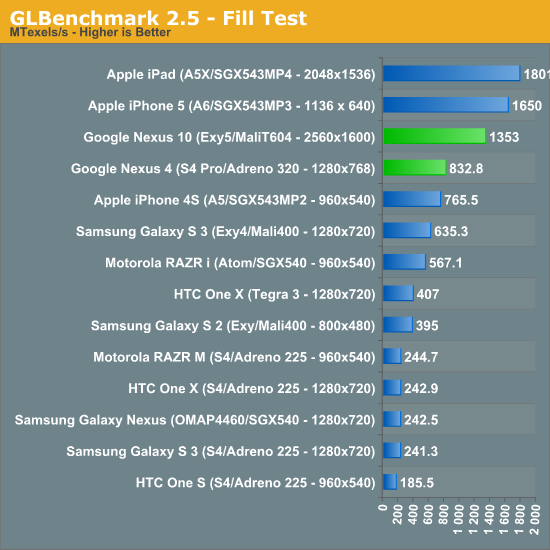
As far as raw fillrates are concerned, both Nexus devices do quite well here at their native resolutions. The iPad and iPhone 5 are both quicker, but we're still good gains over the previous generation of hardware - particularly for the Mali-T604. Compared to the Mali-400MP4 in the Galaxy S 3, we're seeing more than 2x the performance out of ARM's latest GPU.
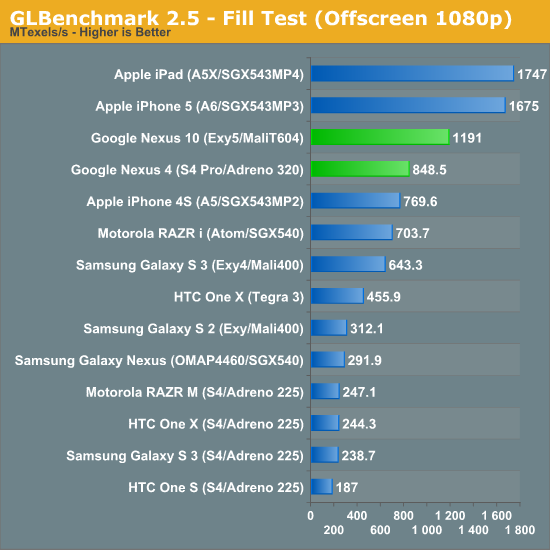
At normalized resolutions the standings don't really change.
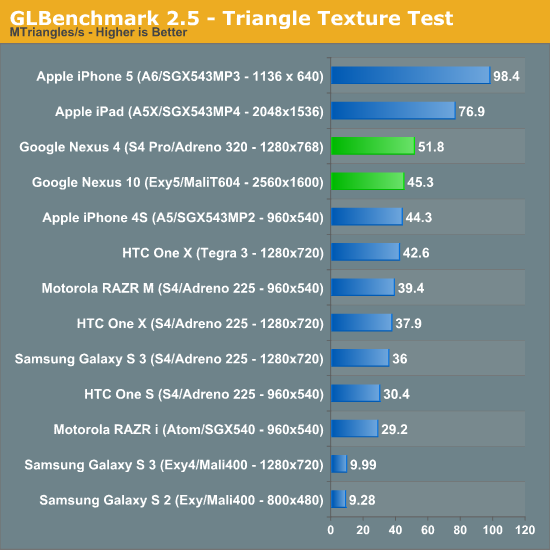
The T604 is ARM's first unified shader architecture, which gives it far more balanced pixel/vertex shader performance. The result is a more than 4x increase in triangle throughput compared to the Mali 400MP4. It's not enough to give the Nexus 10 the edge over the latest Apple devices, but it's a huge improvement over where ARM was in the previous generation. The Adreno 320 continues to be quite strong here as well.
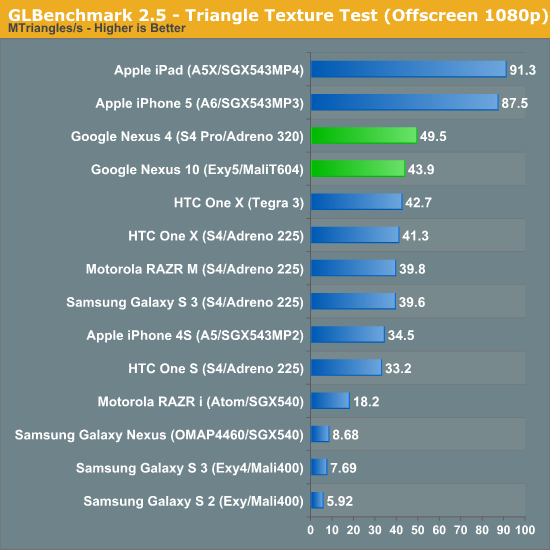
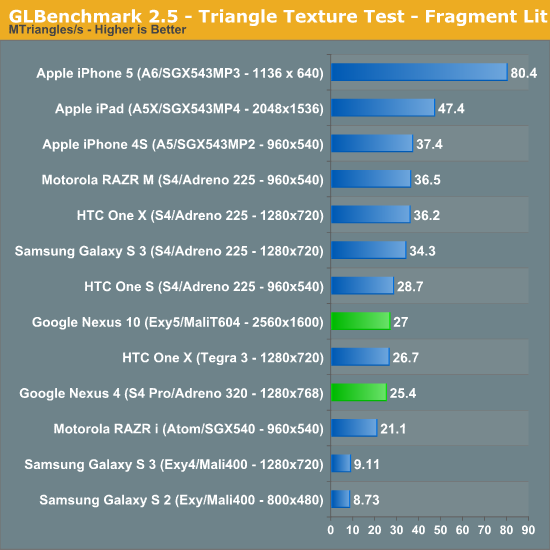
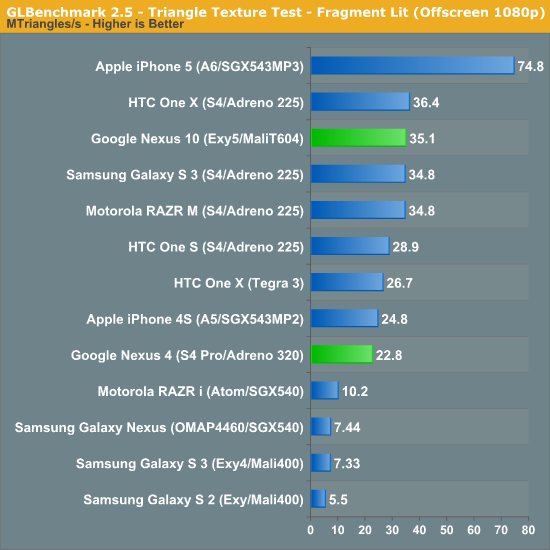
Once again we're seeing huge gains for the Mali-T604 compared to the Mali-400MP4. The Adreno 320 in the Nexus 4 actually performs worse than the Adreno 225 in older devices, possibly due to thermal throttling we saw on the Nexus 4 sample during periods of heavy load.
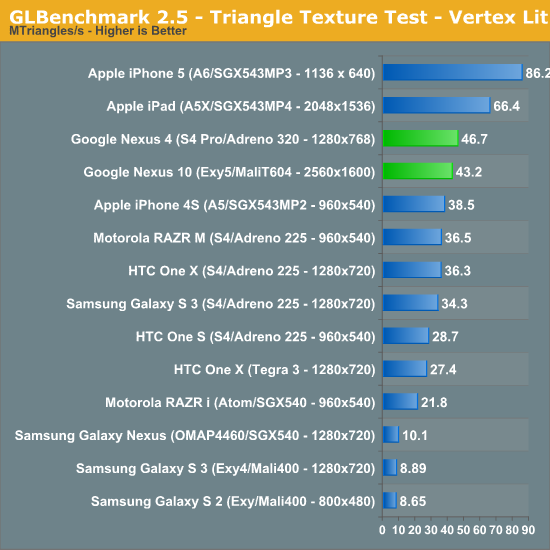
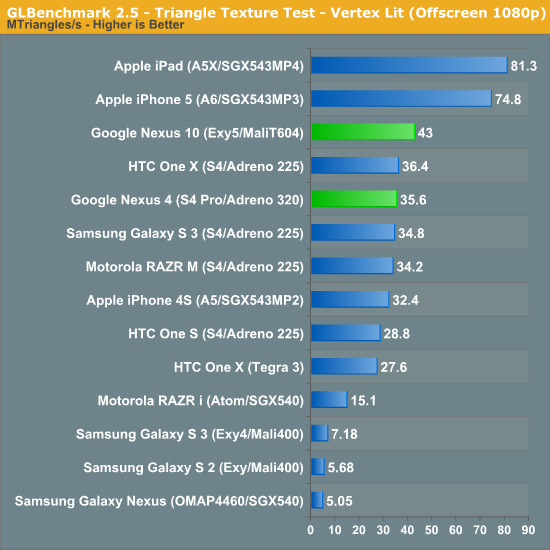
ARM shows the biggest gains here once again thanks to its move to a unified shader architecture. The Adreno 320 does ok here but it's really no better than the 225, I suspect there is some thermal throttling happening on the device.
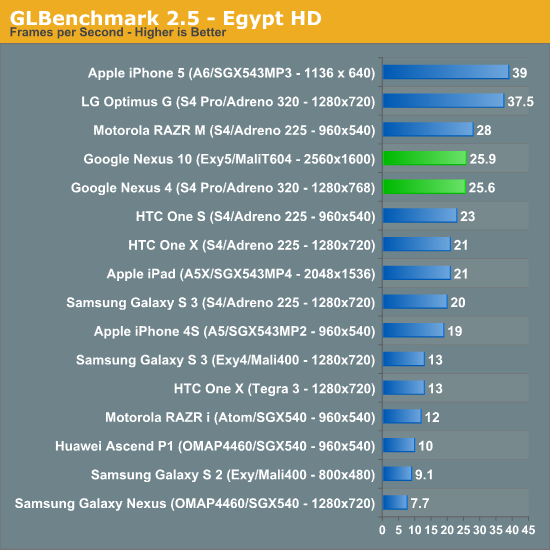
At native resolutions, the Nexus 10 and NExus 4 are both capable of putting out decent frame rates in Egypt HD. What this data tells us is they'll likely be able to run current and even some future titles, at native res, at 30 fps without much of an issue.
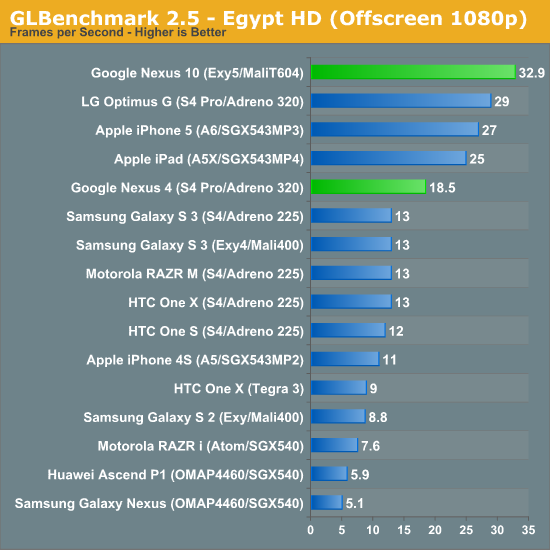
Normalize resolution and the Mali-T604 actually does very well here, setting a new performance record. Despite being based on the same hardware, the Optimus G is able to post a much higher score here than the Nexus 4. The explanation is simple: the Optimus G can't complete a single, continuous run of GLBenchmark 2.5 - the app will run out of texture memory and crash if you try to run through the entire suite in a single setting. The outcome is that the Optimus G avoids some otherwise nasty throttling. The Nexus 4 on the other hand manages to complete everything, but likely quickly throttles its clocks down due to thermal constraints. The Nexus 4 was really hot by the end of our GLBenchmark run, which does point to some thermal throttling going on here. I do wonder if the Snapdragon S4 Pro is a bit too much for a smartphone, and is better suited for a tablet at 28nm.
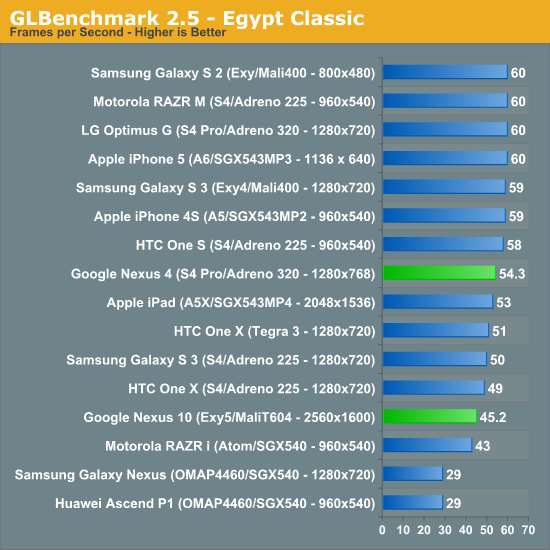
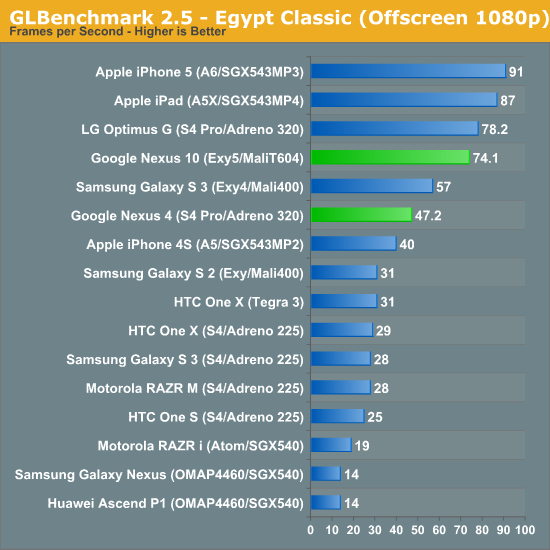
The Egypt Classic numbers are less interesting, but both platforms do well here.
Battery Life
We didn't have time to run through our entire battery life suite, but we do have some relevant results for the two devices. For smartphones, these are our latest web browsing battery life tests:
We regularly load web pages at a fixed interval until the battery dies (all displays are calibrated to 200 nits as always). The differences between this test and our previous one boil down to the amount of network activity and CPU load.
On the network side, we've done a lot more to prevent aggressive browser caching of our web pages. Some caching is important otherwise you end up with a baseband test, but it's clear what we had previously wasn't working. Brian made sure that despite the increased network load, the baseband still had the opportunity to enter its idle state during the course of the benchmark.
We also increased CPU workload along two vectors: we decreased pause time between web page loads and we shifted to full desktop web pages, some of which are very js heavy. The end result is a CPU usage profile that mimics constant, heavy usage beyond just web browsing. Everything you do on your smartphone ends up causing CPU usage peaks - opening applications, navigating around the OS and of course using apps themselves. Our 5th generation web browsing battery life test should map well to more types of smartphone usage, not just idle content consumption of data from web pages.
As always we test across multiple air interfaces (3G, 4G LTE, WiFi), but due to the increased network load we actually find that on a given process technology we see an increase in battery life on faster network connections. The why is quite simple to understand: the faster a page is able to fully render, the quicker all components can drive down to their idle power states.
All Android tests use Chrome and 5GHz WiFi unless otherwise listed.
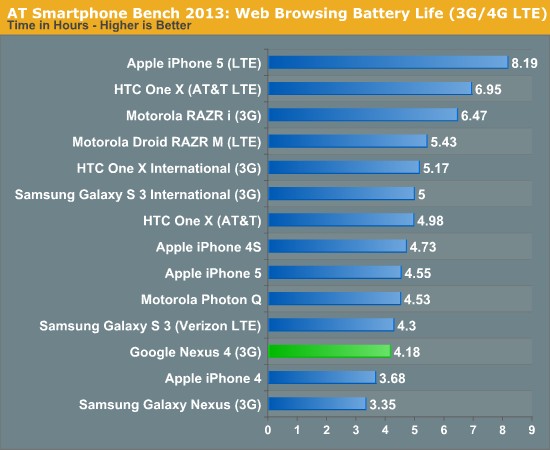
The Nexus 4 doesn't break any records for 3G battery life, it ends up relatively low on our list - even the Galaxy S 3 manages to do better here on 3G.

WiFi battery life is similar to the Galaxy S 3, but again it's not all that impressive compared to some of the other devices in this list.
Our tablet web browsing battery life test isn't directly comparable to the new smartphone tests, so we've got a separate chart for the Nexus 10:
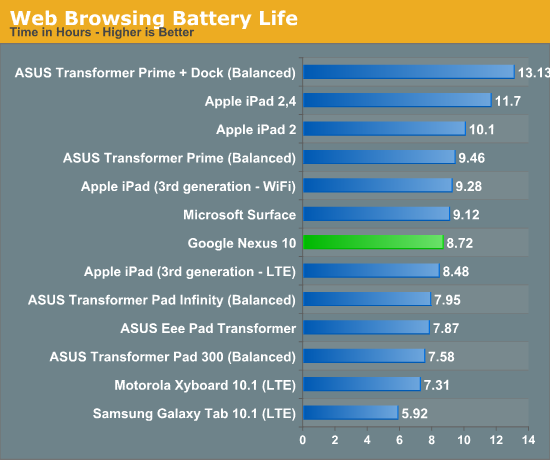
Despite driving a very high res panel, Google is able to deliver relatively competitive battery life with the Nexus 10. Battery capacity is around 80% the size of the 3rd gen iPad and battery life is around 93% of what Apple delivers here. Over 10 hours would be nice to have, but 8 hours of use in this test isn't bad at all. We'll have to do more testing to understand Exynos 5's power behavior a bit better, but so far it doesn't seem that the platform is all that bad from a power consumption standpoint. It remains to be seen how gracefully the Nexus 10 will handle being taxed heavier.
Display
We're still running our big display analysis routines on the new Nexus devices, but the brightness/contrast data below is a little teaser:
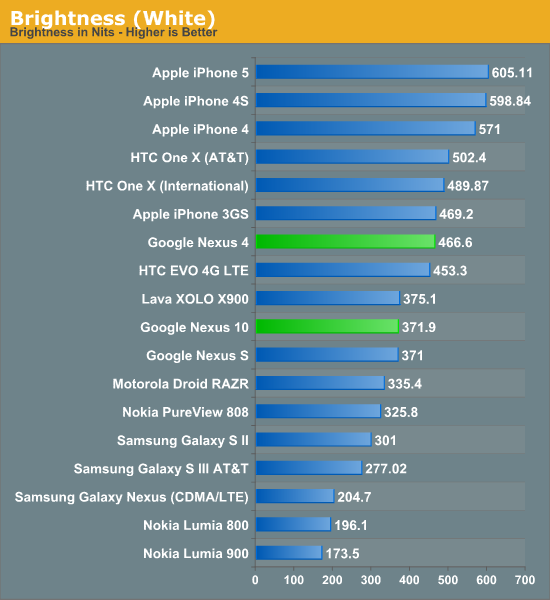
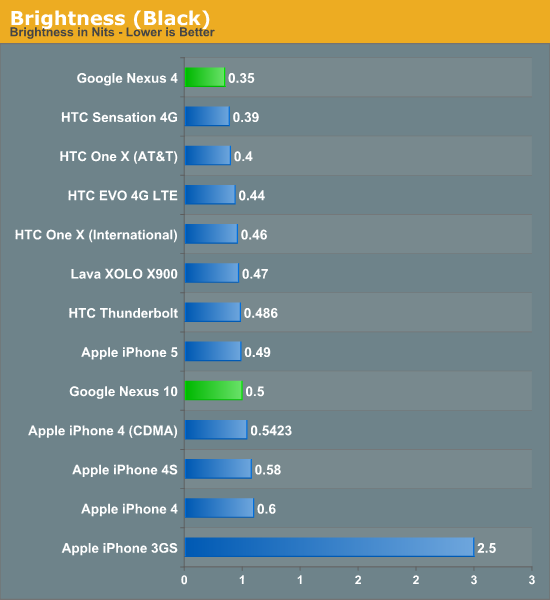
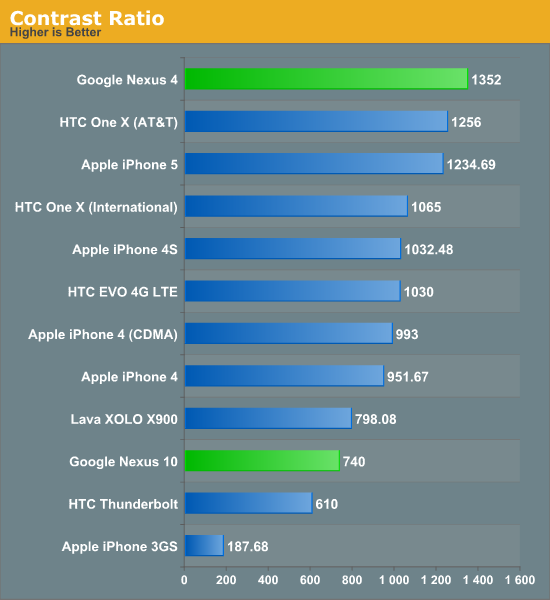
Final Words
We still have a lot of additional writing and testing ahead of us. Stay tuned for our full review of both devices!










244 Comments
View All Comments
UANib - Friday, November 2, 2012 - link
1417ms PING?! WTF?tuxRoller - Friday, November 2, 2012 - link
There seems to be serious issues with mobile Chrome and stock browser has serious standards deficiencies.juicytuna - Friday, November 2, 2012 - link
Yep. Why can't the combine the speed of the stock browser with the standard compliant behaviour of Chrome. Baffling!tuxRoller - Saturday, November 3, 2012 - link
Browsers are ridiculously complicated but the ways things are with android, currently, is that it looks like they are working with two code bases.Moving completely over to Chrome would help alot.
In the meantime, Firefox is using a single code base so, aside from extensions which are so XUL dependent, things that work on the desktop should work in mobile.
tr1stan - Friday, November 2, 2012 - link
Optimus G is clearly over 30% faster than Nexus4 in GPU tests. They both using Adreno 320. Why?tuxRoller - Saturday, November 3, 2012 - link
As they said several times, they had thermal issues.The Optimus G uses a different, thicker, casing than the Nexus, so that may be the difference.
Aside from that, I'm puzzled by these results (which seem to be consistent across the sites). The s4 pro seems simply slower than the s4 (especially the one in the One S).
I'd really like to see AT run the Dhrystone benchmark so we can see the variance from what was supposed to be the case.
Checkout http://www.tomshardware.com/reviews/snapdragon-s4-... where they find the DMIPS to be vastly lower than the 3.1 we were expecting (along with a memory interface that is only on par with the OMAP 4430).
Why hasn't AT brought this up? Krait isn't next generation. It is only a bit better than A9, in general. Far behind Apple's A6 and, presumably, the Cortex A15.
wsw1982 - Saturday, November 3, 2012 - link
I think the krait is not far behind the cortex A15 in the same power range. We already see the performance difference of A15 between chromebook and Nexro 10. I suppose the difference is caused by the lower TDP in tablet. If the power consumption of A15 is further scaled down to the mobile level, who knows how performance wise it compare to krait.The only different between krait, swift and A15 are they target different market, A15 to me is like netbook level processor, more like a low power AMD APU, but the krait and swift target mobile phone and tablet.
To me, ARM is not necessory means low power, it would not surprise me if I the server level ARM has a similar TDP as the intel offers.
Krysto - Saturday, November 3, 2012 - link
There's no difference in TDP. It's the exact same chip, manufactured with the exact same process. It's just Chrome for Android that sucks compared to desktop Chrome/Chrome OS.tuxRoller - Sunday, November 4, 2012 - link
Well, AT were complaining of presumed thermal throttling in the phone while the netbook probably can dissipate a good deal more heat.Aside from that, yeah, chrome for android is terrible which is why i suggested they use firefox since that is available on all android devices of late.
tuxRoller - Sunday, November 4, 2012 - link
Again, checkout the link I gave above. They looked at both the s4 and s4 pro. Those weren't next gen results.Toms hasn't run the tests with the A6/swift yet, and AT ran extensive tests but only against other apple processors, but I expect swift to be a good deal quicker in general purpose benchmarks (kraken/geekbench/pts) clock-for-clock.